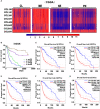The tumor-associated fibrotic reactions in microenvironment aggravate glioma chemoresistance
- PMID: 38863628
- PMCID: PMC11165034
- DOI: 10.3389/fonc.2024.1388700
The tumor-associated fibrotic reactions in microenvironment aggravate glioma chemoresistance
Abstract
Malignant gliomas are one of the most common and lethal brain tumors with poor prognosis. Most patients with glioblastoma (GBM) die within 2 years of diagnosis, even after receiving standard treatments including surgery combined with concomitant radiotherapy and chemotherapy. Temozolomide (TMZ) is the first-line chemotherapeutic agent for gliomas, but the frequent acquisition of chemoresistance generally leads to its treatment failure. Thus, it's urgent to investigate the strategies for overcoming glioma chemoresistance. Currently, many studies have elucidated that cancer chemoresistance is not only associated with the high expression of drug-resistance genes in glioma cells but also can be induced by the alterations of the tumor microenvironment (TME). Numerous studies have explored the use of antifibrosis drugs to sensitize chemotherapy in solid tumors, and surprisingly, these preclinical and clinical attempts have exhibited promising efficacy in treating certain types of cancer. However, it remains unclear how tumor-associated fibrotic alterations in the glioma microenvironment (GME) mediate chemoresistance. Furthermore, the possible mechanisms behind this phenomenon are yet to be determined. In this review, we have summarized the molecular mechanisms by which tumor-associated fibrotic reactions drive glioma transformation from a chemosensitive to a chemoresistant state. Additionally, we have outlined antitumor drugs with antifibrosis functions, suggesting that antifibrosis strategies may be effective in overcoming glioma chemoresistance through TME normalization.
Keywords: antifibrosis therapy; cancer-associate fibroblasts; chemoresistance; glioma; tumor microenvironment (TME); tumor-associated fibrotic reaction.
Copyright © 2024 Xu, Zhang, Chen and Ni.
Conflict of interest statement
The authors declare that the research was conducted in the absence of any commercial or financial relationships that could be construed as a potential conflict of interest.
Figures




Similar articles
-
IGFBP6 controls the expansion of chemoresistant glioblastoma through paracrine IGF2/IGF-1R signaling.Cell Commun Signal. 2018 Sep 19;16(1):61. doi: 10.1186/s12964-018-0273-7. Cell Commun Signal. 2018. PMID: 30231881 Free PMC article.
-
Acquisition of chemoresistance in gliomas is associated with increased mitochondrial coupling and decreased ROS production.PLoS One. 2011;6(9):e24665. doi: 10.1371/journal.pone.0024665. Epub 2011 Sep 9. PLoS One. 2011. PMID: 21931801 Free PMC article.
-
Acquisition of temozolomide chemoresistance in gliomas leads to remodeling of mitochondrial electron transport chain.J Biol Chem. 2010 Dec 17;285(51):39759-67. doi: 10.1074/jbc.M110.147504. Epub 2010 Sep 24. J Biol Chem. 2010. PMID: 20870728 Free PMC article.
-
Exosomes in the Chemoresistance of Glioma: Key Point in Chemoresistance.J Cell Mol Med. 2025 Feb;29(4):e70401. doi: 10.1111/jcmm.70401. J Cell Mol Med. 2025. PMID: 39950738 Free PMC article. Review.
-
NcRNAs: Multi‑angle participation in the regulation of glioma chemotherapy resistance (Review).Int J Oncol. 2022 Jun;60(6):76. doi: 10.3892/ijo.2022.5366. Epub 2022 May 4. Int J Oncol. 2022. PMID: 35506469 Free PMC article. Review.
Cited by
-
Establishment of U-87MG Cellular Fibrosis as a Novel in Vitro Model to Analyze Glioblastoma Cells' Sensitivity to Temozolomide.Int J Mol Sci. 2025 Jun 25;26(13):6121. doi: 10.3390/ijms26136121. Int J Mol Sci. 2025. PMID: 40649899 Free PMC article.
-
Engineered CAF-cancer cell hybrid membrane biomimetic dual-targeted integrated platform for multi-dimensional treatment of ovarian cancer.J Nanobiotechnology. 2025 Feb 5;23(1):83. doi: 10.1186/s12951-025-03165-9. J Nanobiotechnology. 2025. PMID: 39910555 Free PMC article.
-
Integrative bioinformatics analysis of high-throughput sequencing and in vitro functional analysis leads to uncovering key hub genes in esophageal squamous cell carcinoma.Hereditas. 2025 Mar 14;162(1):38. doi: 10.1186/s41065-025-00398-4. Hereditas. 2025. PMID: 40087784 Free PMC article.
References
-
- Stupp R, Hegi ME, Mason WP, van den Bent MJ, Taphoorn MJ, Janzer RC, et al. . Effects of radiotherapy with concomitant and adjuvant temozolomide versus radiotherapy alone on survival in glioblastoma in a randomised phase III study: 5-year analysis of the EORTC-NCIC trial. Lancet Oncol. (2009) 10:459–66. doi: 10.1016/S1470-2045(09)70025-7 - DOI - PubMed
Publication types
LinkOut - more resources
Full Text Sources

